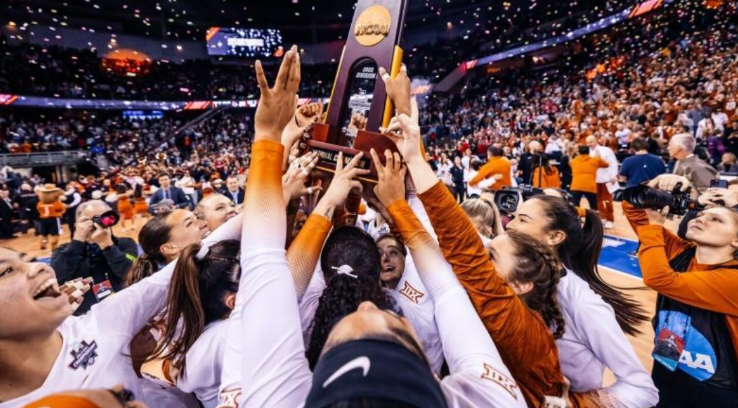Reign of Super Seniors and Transfers in NCAA D1 Volleyball
By Grace Qian | March 24, 2023

Established on October 15, 2018, the NCAA Transfer Portal is proving to be transformational in collegiate athletics on all levels. This virtual portal provides an organized system for managing athletes’ transfer processes as well as enable student-athletes to make known their desire to be a competitor for other programs. Before the COVID-19 Pandemic, the Portal was already a massive topic in not just NCAA volleyball but in all NCAA sports.
And it has only blown up since then.
The NCAA is currently in the 3rd recruiting cycle of athletes who can get an extra year of eligibility due to the pandemic – this means that there are much more volleyball players in the portal than ever before.
In Division I Volleyball, around 250 graduates entered the Transfer Portal during and after the fall season of 2022. Of course, this large influx of players influences the recruitment of both the “normal” transfers and high school recruits as well. There’s one more year of this to come (affects 2021, 2022, and 2023 seasons), so the Portal is going to remain a big issue in the immediate term.

However recently, the Portal has become an even hotter topic when 6 2022 transfer student athletes (including UCLA graduate transfer Zoe Fleck and Kentucky transfer outside hitter Madison Skinner) moved to Texas to help them win the 2022 NCAA D1 Women’s Volleyball Championships. I want to investigate how the stats changed for teams overall in the NCAA D1, as well as if this caused a change in teams in the finals: were there some surprise teams, or were the bracket predictions from the beginning of the season accurate?
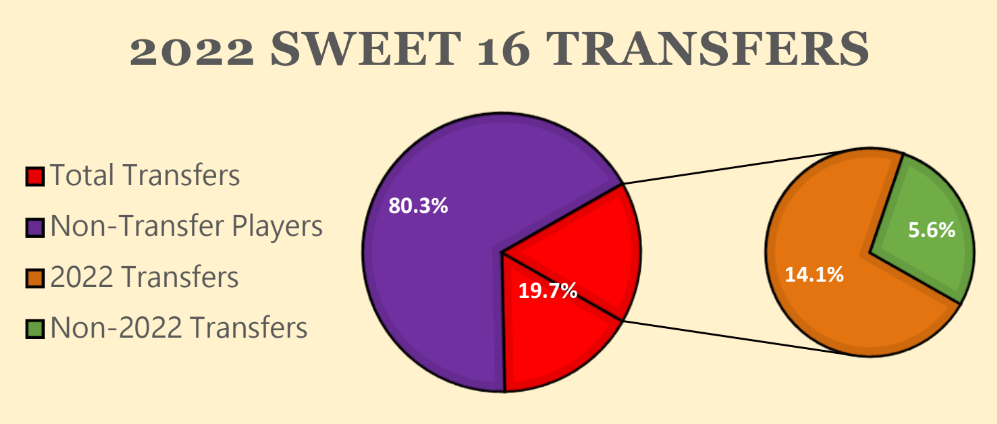
The transfer system played a huge role in the NCAA D1 2022 Championship Tournament. Only 14 of the 64 teams competing had no transfers and that included just two of the final 16, Stanford and Ohio State. From the stats, I made a double pie chart showing just how many transfers participated in the 2022 Sweet 16 matches (there were 50 transfers out of 254 total players, and 36 of those transfers were 2022 season transfers).
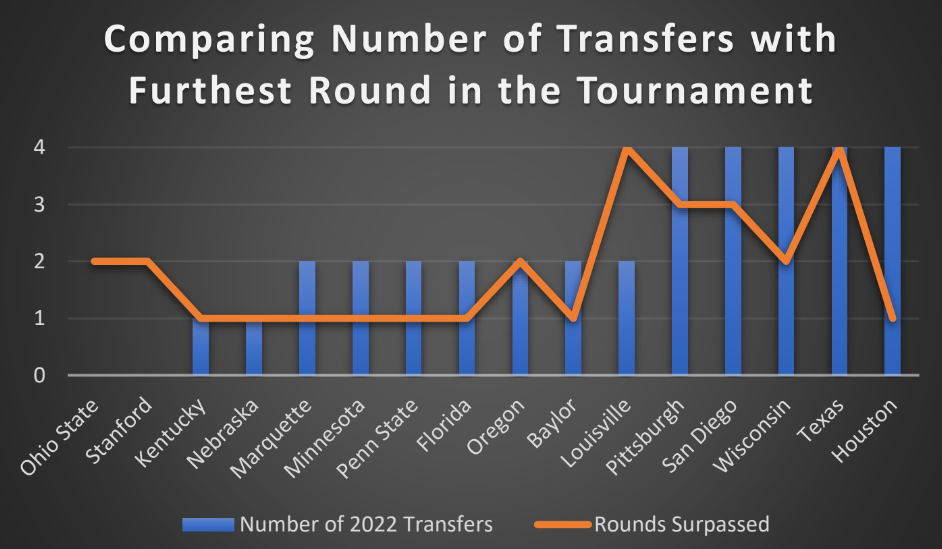
Although there is no correlation between the number of transfers and how far the team got in the tournament (as seen from the chart above – just Sweet 16 teams), there is something that can be said about playing trends. The teams that used transfers and super seniors plus graduate students (those with one more year of eligibility) wisely ended up further along in the tournament. For example, regarding the case of Texas in 2022, ESPN and Big Ten Network volleyball analyst Emily Ehman argued that “I don't think Texas wins the championship without the transfer portal.” It is now evident the 6 transfer players they brought in were essential for coach Jerritt Elliott’s Longhorn team in their overall success.
One of the major pitfalls of Texas in the 2021 season was their defense – to counter this, they brought in grad student libero Zoe Fleck, as well as Nebraska transfer Keonilei Akana. With 2022 Colorado transfer Jenna Ewert and 2022 Utah transfer Saige Ka'aha'aina-Torres as setters, Texas was able to effectively provide consistent passes and sets to their outsides and middles (who have always been effective). From the bar chart below, it is clear that Texas never suffered offensively in past seasons – only defensively. Improving their setting didn’t hurt either. Their hitting percentages remained relatively the same from 2021 to 2022 (0.343 and 0.336 respectively).
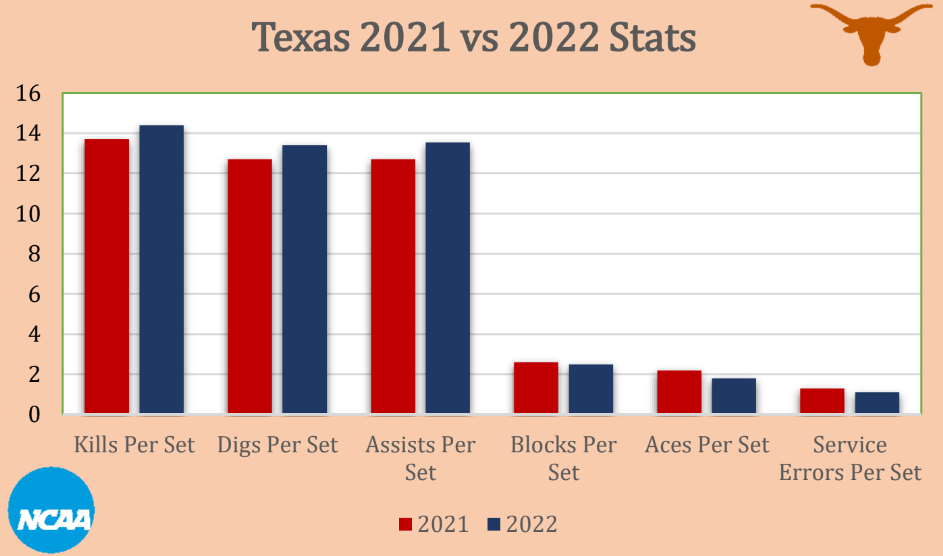
Final Four in the Past Two
Focusing on the Final Four teams in the past two years, let’s see how much their stats changed from 2021 to 2022 (first two years that players were allowed to extend their eligibility due to COVID-19 pandemic).
In 2021, the Final Four teams were Wisconsin, Nebraska, Louisville, and Pittsburgh. In 2022, the Final Four teams were Texas, Louisville, San Diego, and Pittsburgh. Louisville made appearances in both championships, which is interesting and important to note as 2021 was the first time they made it to the Final Four in their program history.
One of the most exciting games to watch (for me personally) was the 2021 Championship – the Wisconsin Badgers and the Nebraska Cornhuskers battled it out to a grueling fifth set, which was won by the Badgers.
I argue that the main reason why this game was so enthralling is due to the additional year of eligibility available. Both Wisconsin and Nebraska shared nearly point-to-point statistics, as shown below – and these statistics were a result of the first round of “super seniors”. The cohort was evenly matched for both sides (Lauren Stivrins vs Dana Retke, Lauren Barnes vs Lexi Rodriguez, Sydney Hilley vs Nicklin Hames).
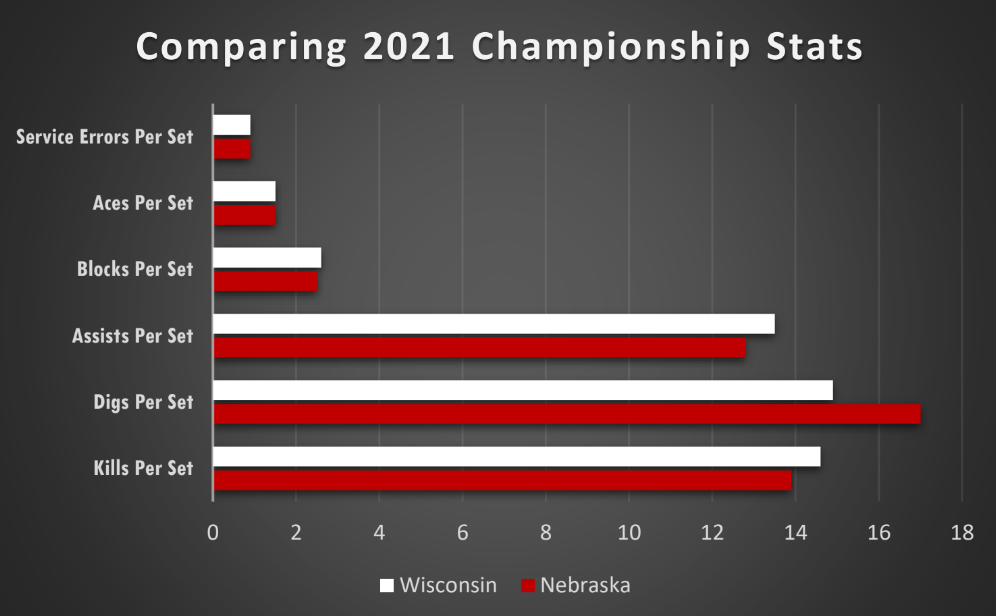
Key Transfers in the 2021 and 2022 NCAA D1 Volleyball Seasons
Many transfer students in the past two volleyball seasons played pivotal roles in leading their teams to victory – and into the Final Four.
Lauren Barnes (2021)
In her last year of eligibility, seasoned libero and defensive specialist Lauren Barnes led her Wisconsin team to victory in the NCAA D1 2022 Championships. With her impressive fast-react plays and ability to get seemingly impossible balls up, she led in digs with 531 total digs and 4.35 digs per set. This Minnesota transfer provided a solid defensive effort for Wisconsin, as well as creating opportunities for her teammates. Barnes effectively filled the cavity of previous Wisconsin All-American libero Tiffany Clark (who graduated).
Zoe Fleck (2022)
Graduate student Zoe Fleck has undergone the transfer process more than the average player (UCSB to UCLA, UCLA to Texas), and it definitely paid off for her! Her sheer athleticism and stealthy reactions earned her two-time Pac-12 Libero of the Year at UCLA and starting libero at Texas in 2022. Fleck played a crucial role in solidifying a defensive force for Texas alongside Nebraska transfer DS Keonilei Akana. She led the team with 4.42 digs per set for the 2022 season.
Gabby Blossom (2022)
Gabby Blossom left the Happy Valley to join the San Diego Toreros for her final season – and she proved to be an essential member of her new team. Averaging at 11.92 assists per set, Blossom’s impeccable placement of the ball provided her hitters with more options, and more chances to score points. She was a key part of helping USD reach their first even national appearance in the championships, beating out Stanford in the Elite 8!
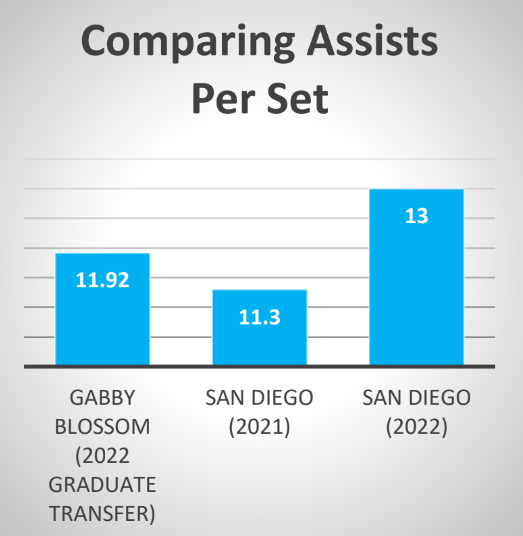
Raquel Lazaro (2022)
Named ACC Setter of the Year, 6-ft volleyball player Raquel Lazaro was a key part of the 2022 National Championship Team, playing in 115 sets. She averaged in 10.07 assists per set. As a graduate student transfer from USC, Lazaro had big shoes to fill – the Louisville Cardinals had just lost their previous All- American setter Tori Dilfer. But Lazaro did more than just fill these shoes – she surpassed all expectations and brought her team to appear in the 2022 D1 Finals!
Julianna Dalton (2022)
Just a sophomore, Dalton proved her true ability and prowess as an outside hitter for the Pitt Panthers. She is a member of Pitt’s 2022 NCAA Final Four team and led them to their second consecutive National Semifinal appearance. Dalton provided both an offensive arsenal as well as a solid defensive block for the blue-and-gold.
Caroline Crawford (2022)
Middle blocker Caroline Crawford transferred from Kansas to Wisconsin – and she thrived at Wisconsin. Her blocks were a solid wall in the 2022 NCAA Championships – nothing could get past her. With a hitting percentage of 0.305 and 1.43 blocks per set, Crawford and fellow middle blocker Danielle Hart proved difficult to overcome for the Wisconsin 2022 team.
Dominating Super Seniors in the 2021 and 2022 NCAA D1 Volleyball Seasons
Lauren Stivrins (2021)
Super Senior and “super” player Lauren Stivrins will remain a legendary player in Nebraska’s Volleyball Hall of Fame. Recognized as first-team All-Big Ten for the five years straight, Stivrins led her team during her senior year in hitting percentage with an astounding 0.339. In March 2022, Stivrins is making her debut in Athletes Unlimited Pro – a professional sports league.
Dana Retke (2021)
Dana Retke spent her last year of eligibility winning the 2021 NCAA D1 Volleyball Championships with her Wisconsin team. Like Stivrins, she is also a decorated player, named AVCA First-Team All- American for five years straight. Standing at 6-ft-8-inches and with a career average hitting percentage of 0.422, Retke’s insane kills were a force to be reckoned with. She currently plays pro volleyball for Vero Volley Monza in the Italian Serie A1 League.
Sydney Hilley (2021)
Seasoned Wisconsin setter and team captain Sydney Hilley was part of the talented Wisconsin team that won the 2021 championships. With a career-average of 11.85 assists per set, there’s no debate as to why she made the 2019 and 2020 AVCA First-Team All-American. She currently ranks fourth at Wisconsin with 4,680 assists!
Logan Eggleston (2022)
Super senior Logan Eggleston is an outstanding outside hitter reigning from Texas. In her final season of eligibility, she led her team to victory in the 2022 NCAA D1 Volleyball Championship Finals with 4.28 kills per set (the highest on her team). Eggleston rightfully won VolleyballMag.com Player of the Year (2022) with her leadership and playing skills.
Claire Chaussee (2022)
Named ACC Player of the Year (2022), Claire Chaussee had 25 matches in double-digit kills. As a 6- rotation player, Chaussee grew into her role as both a defensive force and offensive weapon for the Louisville Cardinals. Under her experienced and seasoned leadership, she led her team to their second NCAA appearance, and to the 2022 Championship Finals, before falling to Texas. Chaussee hopes ot continue playing volleyball professionally in Europe.
Brooke Nuneviller (2022)
Brooke Nuneviller can do it all – she switched from playing Oregon’s libero her freshman year to 6- rotation outside player for the rest of her Oregon volleyball career. As a super senior, Nuneviller led her team to another appearance in the 2022 Elite 8. Nuneviller and fellow outside hitter Mimi Colyer proved offensive weapons for Oregon in the 2022 season. Nuneviller ended with a career average 3.73 digs per set and a career high hitting percentage of 0.281.
Katie Lukes (2022)
San Diego outside hitter Katie Lukes was named 2022 WCC Player of the Year. She ended her college volleyball career with 3.46 kills per set. A redshirt senior, Lukes’ experience helped her team make their first ever Final Four appearance in the 2022 NCAA D1 Championships. Lukes was also named WCC Offensive Player of the Week multiple times – reflective of her dynamic offensive plays.
Changing the Name of the Game
But how much did these transfers really change the game?
One of the main changes I noticed is the rise in rank of “underdog” teams. While before these teams would just barely “scrape through” the first round, they are now able to make it to the Elite 8 and even the Final 4. The most noticeable instance of this is with USD – the Toreros made their first ever NCAA appearance with graduate transfer Gabby Blossom and Super Senior Katie Lukes, as well as BYU transfer student Madi Allen (L/DS) and another redshirt senior Annie Benbow (who was the starting libero for SD). Another case is with the Louisville Cardinals – they made their first ever Final 4 appearance in 2021, and they have only continued this upward trend in rankings, ending with the No. 2 spot in the 2022 tournament.
So what does this mean for the NCAA D1 Volleyball program?
Well, for starters, the games will be a lot more competitive – with teams using the transfer portal to fill missing “cavities” for players that have graduated or transferred to other schools, there is more talent being evenly distributed throughout the NCAA. There will be a lot more wild cards and unpredictable games – which will all add to the fun and excitement of each season.
All good news.
But there are some bad news. With so many players in the transfer portal, there is a whole lot of chaos. What’s really going to be interesting is how different colleges and universities deal with scholarships. Additionally, the Portal is going to remain a big issue in the immediate term (2023 season) due to the large influx of “COVID” players extending and using their extra year of eligibility. Effects of large rosters and the player mentality of “If I don’t like it I’ll just transfer” mindset can be harmful to not just the NCAA volleyball program, but to all sports in general.
